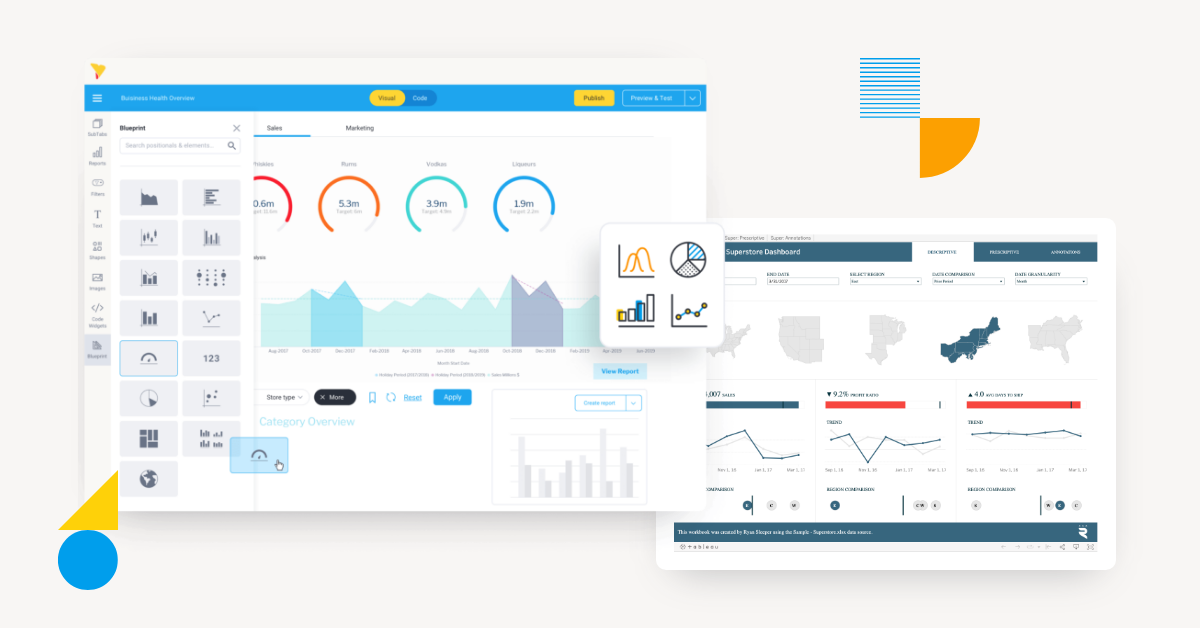
The Hidden Costs of Embedded Analytics: A Pricing Comparison
Embedded analytics solutions have become increasingly popular in recent years, as more organizations across multiple sectors recognize the value of integrating advanced business intelligence (BI) and analytical capabilities into their existing software applications.
Such solutions allow for deeper insights from data to make more informed decisions - this is well established. However, when considering such sophisticated solutions, it is important to be aware of the hidden costs associated with certain embedded analytics options to avoid sticker shock.
In this article, we will compare the pricing models of Yellowfin with other vendors.
What is Yellowfin BI's Pricing Model?
Yellowfin pricing is ideal for independent software vendors (ISVs) and original equipment manufacturers (OEMs) searching for an extensible analytics solution that can white-label analytics into their product. It is specially designed to align with your unique go-to-market model, to ensure predictability and scalability without hidden costs or surprises.
Yellowfin approaches pricing for its embedded analytics platform with the mantra of “simple, predictable, and scalable”, dividing its pricing packages between two plans.
1. Embedded Analytics (For Software Vendors)
Best suited for developers, this pricing plan is categorized into 3 simple models.
- Aligned Utility Model: Price Per Unit - Pricing is based on your analytics usage and how you sell. Yellowfin adjusts our pricing model to your pricing model. e.g. by site, by app, bus, by device, etc.
- Revenue Share Model: Pricing is based on supporting add-on analytics, with pricing based on the value of revenue from add-on analytics modules.
- Server Core: Pricing is based on server deployment, with a fixed price based on server core (for example, 4 core deployment) and which scales only as your deployment needs scale.
Yellowfin has several customers that have adopted different pricing plans to suit their business needs. For example, an electronic health records systems (ERS) software vendor who specializes in supporting large-scale enterprises has found the revenue share model to be best suited for their business models, which sees Yellowfin make a percentage of each sale for every deployment to their service provider customers.
2. Enterprise BI
Best suited for large-scale deployments and larger organizations, this pricing plan is also categorized into 3 simple models.
- Named User - Price is based on how many named users have access and is suitable for small to medium sized deployments.
- Server: Price is based on required CPU cores and is suitable for larger deployments.
- User Tier: Price is based on the type of users required, writers (those who connect data source, prepare and analyze data, create and share visualizations through dashboards and reports) or consumers (those who access, interact with, and create data visualizations from published data sources or existing dashboards), giving you flexibility based on your organization's unique data needs.
In addition, Yellowfin provides options for extending, hosting and database selection.
Analytics Plus: This provides everything you get in Yellowfin Analytics + Automated Business Monitoring with Yellowfin Signals. Available on a named user, server and custom pricing basis.
Self Managed or Fully Managed Service: Self manage your own deployment on-premise or in the cloud, or take advantage of a fully managed service and have Yellowfin securely hosted for you — the choice is yours.
Analytical Database: Take advantage of the unrivaled power of a high-performance in-memory analytics database on-premise, in the cloud or both. No platform, vendor or architecture lock-in.
Related Reading: How to Lower TCO and Increase ROI with Embedded Analytics
Yellowfin BI Pricing Summary
In addition to its pricing plans, Yellowfin provides a free live demo with its technical experts, so businesses can test the suite with sample data-sets before purchasing. They also provide proof-of-concepts (POC) at no charge. Select pricing plans have starting prices as low as USD $19.00 per month.
Overall, Yellowfin provides a number of simple, scalable options for organizations looking to buy the best and most affordable embedded analytics solution available on the market.
What is Microsoft Power BI's Pricing Model?
Moving on to Power BI, Microsoft's analytics solution, their pricing model includes both a free version and paid plans. While the free version is appealing, it comes with limitations such as limited data capacity and lack of collaboration features. Organizations requiring advanced features will need to upgrade to a paid plan, of which there are two tiers.
1. Power BI Pro
Power BI Pro is priced per user at a monthly rate of $15, and is primarily geared toward organizations who want to license individual users with analytics and dashboard/data visualization capabilities. For example, you need 20 licenses of Power BI Pro to give 20 users full access to creation of reports and unlimited consumption (viewing) of any created content.
Read our detailed comparison guide on Yellowfin vs Power BI for more information.
2. Power BI Premium
Power BI Premium is priced per user at a monthly rate of $29.90 USD, and is primarily geared toward organizations who want to license individual users with the advanced part of its analytics suite, including data preparation for big data, and enterprise-level management and deployment.
Power BI Premium also has a per capacity pricing tier at $7,475.30 USD per month, which is geared toward organizations who want the entirety of the business to have access to Power BI’s advanced feature-set. The licensing includes users, datasets, and content.
Power BI Pricing Summary
Power BI is heavily tethered to the Microsoft 365 and Microsoft Azure Cloud ecosystems, making it attractive for organizations who want to fully integrate with only the MS software stack for their infrastructure and data needs. Finally, Microsoft notes that currency, country and regional variations can affect the final pricing per user or organization.
What is Tableau's Pricing Model?
A common query we hear is how much does Tableau embedded analytics cost? Compared to other vendors, Tableau's pricing model consists of Creator, Explorer, and Viewer user types, offering varying degrees of functionality.
1. Tableau Creator
Tableau Creator is priced per user at a monthly rate of $75 USD (billed annually), and is primarily geared toward organizations who want to license one user with advanced administration, governance, data prep and content authoring and collaboration capability (i.e. admins, analysts and managers). This tier bundles Tableau Desktop, Tableau Prep Builder and one creator license on Tableau Cloud.
2. Tableau Explorer
Tableau Explorer is priced per user at a monthly rate of $42 USD (billed annually), and is primarily geared toward organizations who want to license individual users with self-service analytics and dashboard/data visualization capabilities (i.e. regular analytics users within the organization). This tier only includes Explorer licensing for Tableau Cloud.
Read our detailed comparison guide on Yellowfin vs Tableau for more information.
3. Tableau Viewer
Tableau Viewer is priced per user at a monthly rate of $15 USD (billed annually), and is primarily geared toward organizations who want to license individual users with the ability to view and use basic interactions with dashboards and data visualizations (i.e. irregular users or end-users who only consume but not create data content). This tier only includes Viewer licensing for Tableau Cloud.
Tableau Pricing Summary
Tableau offers some flexibility in its pricing, but hidden costs may arise if organizations need to allocate more Creator or Explorer licenses to accommodate increased user demand or advanced features.
Additionally, organizations should be aware of potential costs associated with consulting services, training, and support, which are not explicitly outlined on Tableau's pricing page.
What is Sisense and what is Qrvey's Pricing Models?
Sisense and Qrvey advertise customized pricing based on the individual needs of each organization or Software-as-a-Service (SaaS)-based growth models, respectively, and both do not currently list specific pricing or product packages on their websites.
While this approach touts flexibility and scalability, it can introduce potential hidden costs for organizations not yet versed in what competing solutions offer. For example, Qrvey's list price does not include Amazon Web Services (AWS) prices, which customers may or may not be aware of and will have to factor in.
Additional factors such as the number of users, amount of data, and desired features can significantly impact the pricing of analytics solutions, making it essential for businesses to thoroughly assess requirements and negotiate pricing to avoid unexpected expenses.
Other Potential Hidden Cost Factors to Consider
Bad business decisions: When BI is generated by less data literate users, it is often based on flawed analytics. This can be because the underlying data does not meet validity standards, the dimensions selected don't make sense, or the definitions and other metadata are not well understood. For example, comparing monthly revenue with annual expenses can lead to misleading conclusions. It’s important to stay on top of how your end-users interact with your solution and the output they produce to ensure accuracy and relevancy of reporting and dashboards - otherwise, the perceived value of your BI solution and the importance of data overall may lessen.
Data Validity Concerns: Users might also import data from outside the core systems or rely on outdated or invalid data. Utilizing such data can lead to inaccurate analyses and, consequently, flawed business strategies that can lead to increased costs over time.
Generative AI Hallucinations: In cases where BI tools are integrated with AI systems like OpenAI's Copilot that Microsoft is using, using incorrect data can lead to "AI hallucinations"—situations where the AI generates misleading or incorrect suggestions. This can further exacerbate the problems mentioned above.
These can lead to:
- Erosion of Trust: When analyses are consistently incorrect or misleading, it can erode trust within the organization. This can actually lead to a culture of low trust in data, because if you can't trust everything you can't trust anything. Teams might start to double or triple-check everything, leading to delays, inefficiencies, and wasted time.
- Increased Support Costs: The use of incorrect data often results in increased support tickets, as users turn to the data team for clarification. This not only increases operational costs but also diverts the data team from more strategic tasks.
- IP Risks: In addition to the hallucinations above, there may be a risk to IP the data used by Co Pilot or other generative transformers. Though not specifically copied and retrievable in its raw form, data can be used as training material that shapes the output from the transformer for other users.
Vendor Lock-in
Certain solutions such as Microsoft Power BI are heavily reliant on the vendor’s existing software stack or ecosystem, in this case Microsoft Azure Cloud, and there is a cost associated with lack of flexibility to adjust to evolving business needs as they relate to your data platforms. An agnostic approach to your BI and data infrastructure does not have those potential hidden costs.
Evaluating Analytics Pricing: Conclusion
It is important to consider the hidden costs associated with embedded analytics pricing models when making the decision to integrate new data analysis capabilities into existing software. While the base pricing may seem reasonable, organizations need to examine additional costs such as support, maintenance, and training. These costs can vary significantly depending on the vendor. For example, Tableau offers additional options for technical support and training, which may incur additional charges.
Furthermore, organizations should consider the scalability of each solution. As businesses grow and their needs evolve, it is essential to understand how pricing will change with increased usage or the addition of new users. For example, Yellowfin’s Aligned Utility Model for the Embedded Analytics package offers flexible pricing that aligns with changing analytics usage and how you sell (by site, device, app, bus, etc), providing organizations with greater cost control.
In conclusion, when evaluating embedded analytics solutions, it is crucial to look beyond the initial pricing and consider the hidden costs and long-term implications. By thoroughly analyzing the specific needs and budget of your organization, you can make an informed decision that aligns with your goals and minimizes any hidden costs or unexpected surprises.
Yellowfin Pricing: Flexible and Tailored For You
Yellowfin pricing is simple, predictable and scalable. Learn more about our flexible pricing plans for embedded analytics and enterprise BI today.


